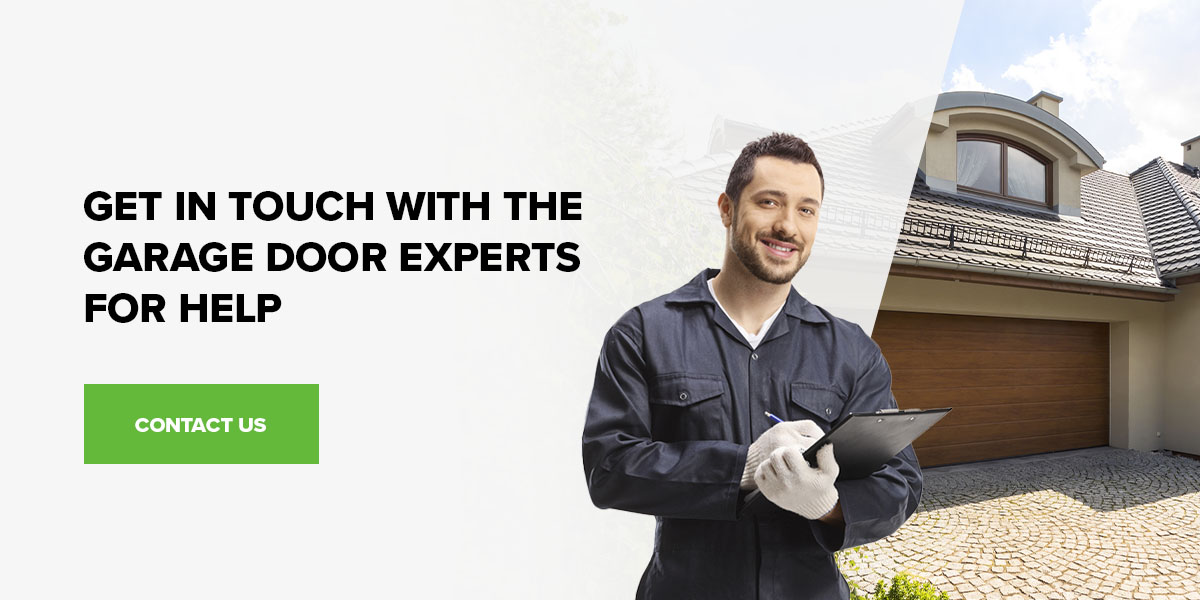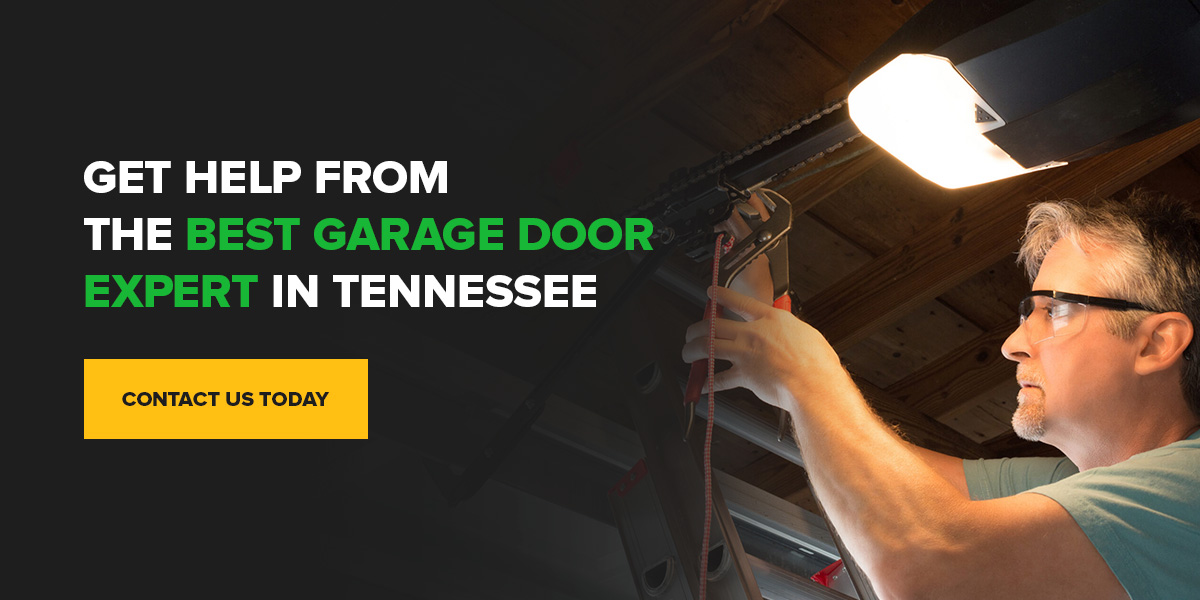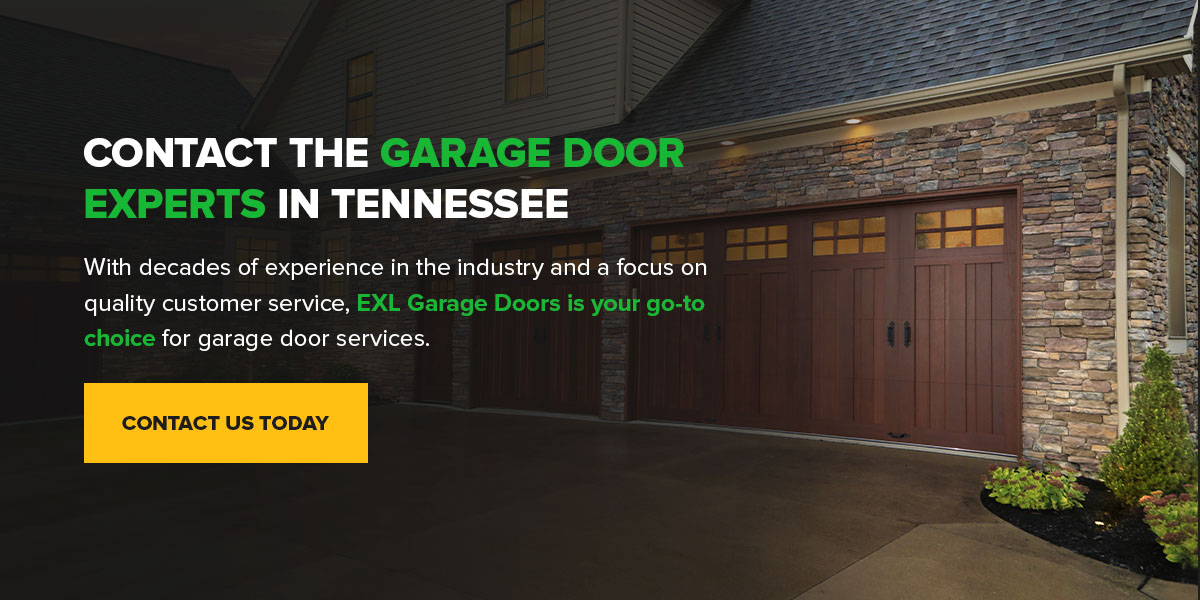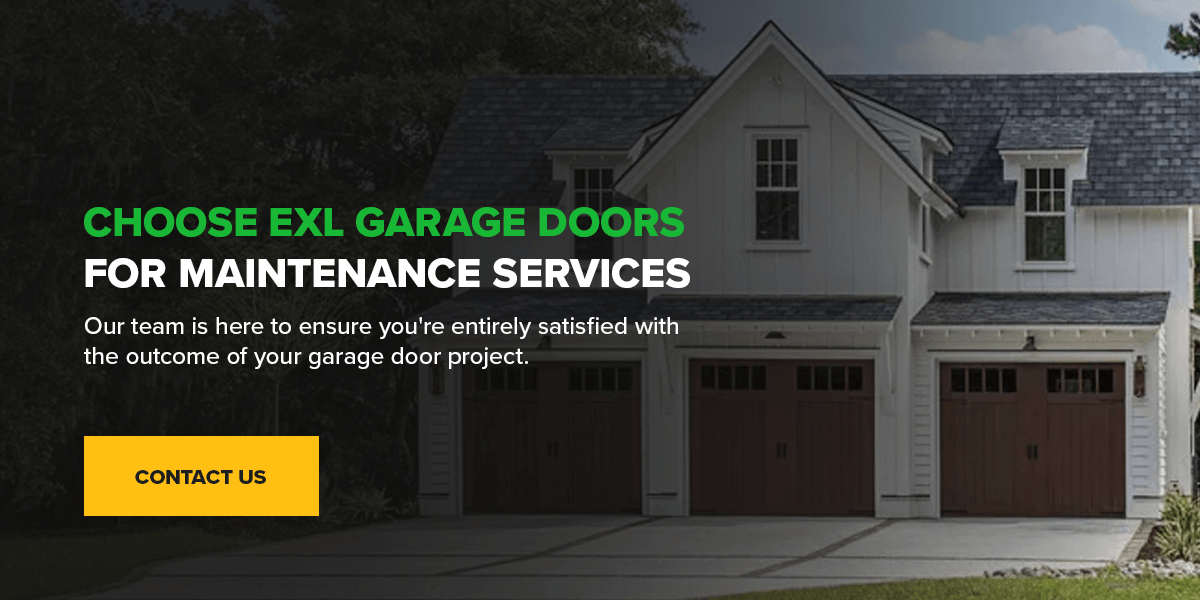How to Fix a Garage Door That Won’t Close All the Way

If your garage door opens just fine but gets stuck at any point on the way down, you need to get the problem taken care of. A stuck door is more than an eyesore — it’s a weak point in the structure of your home that leaves your property exposed to everything the world has to offer. In many cases, a garage door that won’t close all the way is caused by something simple that you can resolve yourself without calling a professional repair service.
Common Reasons Your Garage Door Won’t Close
Dealing with a garage door that won’t close is frustrating. Before you can fix it, however, you must identify the cause. Here are some of the most common reasons why your garage door won’t close:
- Unaligned sensors
- Warped, bent or damaged tracks
- Dirty or broken sensors
- Inaccurate travel limit
- Presence of an obstruction
- Damaged cable
- Broken garage door springs
Useful Tips to Restore Operation to Your Garage Door
Garage doors consist of several components that all contribute to smooth, quiet and reliable operation. If any part of the system is blocked, becomes loose, falls out of alignment or is otherwise prevented from doing its job, it can cause your door to get stuck while closing. Here are some of the first steps you should take when your garage door won’t close:
- Check, clean and align sensors: Sensors are crucial safety features to any system, but they’re notorious for causing issues when they get dirty or fall out of alignment. You should visually inspect and test your sensors to make sure they have power, are free from debris or dirt and are in the right position to operate effectively.
- Check the tracks: The tracks running up the sides of your garage door guide the rollers as the door moves. If they get warped, bent, or damaged, it can stop the door from closing partway down. Check your tracks for apparent signs of damage. Make sure you search for and tighten any loose hardware, clear dirt or grime from the tracks, and lubricate using a silicone spray.
- Check your travel limits: If your garage door won’t close all the way and goes back up to the top, you might be dealing with a travel limit issue that can stop the door before it reaches the ground. While most garage doors have travel limits programmed into them at the time of installation, they can sometimes be incorrect or can slowly shift from their desired setting over time.
- Lubricate moving parts: Being proactive with lubrication for all screws, chains, rollers, hinges and tracks is crucial to ensuring your garage door is ready when you need it. It’s important to check your manufacturer’s recommendations, although it’s best to lubricate your door at least twice a year.
- Inspect various mechanical components: Whether from external forces or routine wear and tear, it’s not uncommon for various mechanical components to experience damage which could lead to improper operation. Checking these areas will allow you to find any signs of corrosion, dents, chips or any other signs of damage, as well as loosened or insecure parts.
Get in Touch With the Garage Door Experts for Help
While the reason for your garage door not closing could be as simple as a stick in the tracks, it could be something more complicated. If you notice any signs of serious damage, such as a broken spring or damaged cables, it’s time to call in the professionals. At EXL Garage Doors, we recognize the importance of your garage door and offer top-of-the-line repair services to keep yours looking and performing its best. We leverage decades of unique industry experience, dedicated training and advanced equipment to supply effective repair and maintenance solutions to restore proper function and ensure you have the peace of mind you deserve in a garage that can close.
Still wondering why your garage door won’t close? Contact our team online to schedule an appointment or request a detailed estimate with our Tennesse professionals today.
Why Does My Garage Door Open and Close By Itself?

When a garage door opens by itself, the reason may be less supernatural than you think. Garage doors are electrical systems and rely on wires, sensors and circuits to make your life easier. When something occurs in the system, it can send signals to your operator telling it to open or close your garage door. These systems are susceptible to damage, interference and more, but in many cases, the cause is something you can likely take care of yourself.
Why Your Garage Door Randomly Opens or Closes by Itself
Here are some possible reasons why your garage door opens by itself randomly:
Blocked Sensors
All garage doors manufactured after 1993 have safety sensors mounted close to the floor or at the base of the tracks. These sensors detect the presence of objects in the path of a closing garage door, and then send invisible signals to reverse the motion and prevent the door from crushing whatever’s there. While sensors are an excellent and essential feature, they can be a problem because they can’t distinguish between large objects and smaller debris like sticks, stones or even dirt.
Misaligned Sensors
Most garage doors have two sensors located on both sides of the door opening. When the sensors get misaligned, it often indicates that an object is obstructing them, which would immediately trigger the safety reverse mechanism.
Damaged Electrical Circuit
Electrical surges or power outages caused by extreme weather conditions may cause damage to your garage door’s electrical circuit. If you suspect that the problem with your garage door began after a power surge, it could be a sign that your electrical circuits are damaged.
Broken Door Springs
The sole purpose of the springs on your garage door is to ensure it opens easily and doesn’t damage or hurt any object or person nearby. When they break, the door won’t operate properly.
Limit Settings
Garage doors usually have limit settings that tell them how far up or down they can go when completely open or closed. So, if your set limits are a little off, you may notice that the garage door goes back up partway after reaching the ground or comes back down a little when you open it.
Wheels Binding in Their Tracks
Sometimes, the tracks guiding your garage door up and down can bend or shift out of place, especially when accidentally hit by something large and heavy like a vehicle, a garbage can or a lawn mower. When this happens, the door’s wheels could bind in their tracks, causing problems when opening and closing.
Identical Garage Door Opener Frequency
The openers of older garage doors transmit signals at a specific frequency and use specific codes to program. If, by a slight chance, your neighbor also has an older garage door model that uses the same opener frequency as yours, your door will open when your neighbor opens theirs.
How Do I Stop My Garage Door From Opening by Itself?
In the best case, a garage door opening by itself can be annoying. In more serious circumstances, it can place your property at risk for theft, expose your home to the elements or lead to injuries and liability concerns. If your garage door acts like it has a mind of its own, check to see if the answer is something simple. To try fixing the issue yourself, follow these steps:
- Check your sensors: Check for alignment, and sweep your garage free of any debris.
- Check your opener: Clean all the buttons on your opener using alcohol, and open the housing to clean the connections. Be sure to inspect your wiring for any loose connections, exposed wires or damage. One of your neighbors may use the same frequency as yours, but with today’s technology, such an issue is unlikely.
- Check the motor: If you have access to a multimeter, you can use it to test the voltage in and out of these components to see if they’re in working condition or hold the answer to your mystery.
- Adjust the limit settings: Review your manual to see where the limit switch is. Typically, you’ll turn a screw for about every 2 inches the door needs to travel to open and close the right amount.
- Realign the door tracks: inspect the guide track for damage and then realign the bent tracks. If they are severely damaged, contact an expert to fix or replace them.
Other issues, like broken garage door springs, are best left to the professionals.
While the reason for your garage door not closing could be as simple as a stick in the tracks, it could be something more complicated. If you notice any signs of serious damage, such as a broken spring or damaged cables, it’s time to call in the professionals. At EXL Garage Doors, we recognize the importance of your garage door and offer top-of-the-line repair services to keep yours looking and performing its best. We leverage decades of unique industry experience, dedicated training and advanced equipment to supply effective repair and maintenance solutions to restore proper function and ensure you have the peace of mind you deserve in a garage that can close.
Still wondering why your garage door won’t close? Contact our team online to schedule an appointment or request a detailed estimate with our Nashville or Gallatin professionals today.
How to Reset a Garage Door After a Power Outage
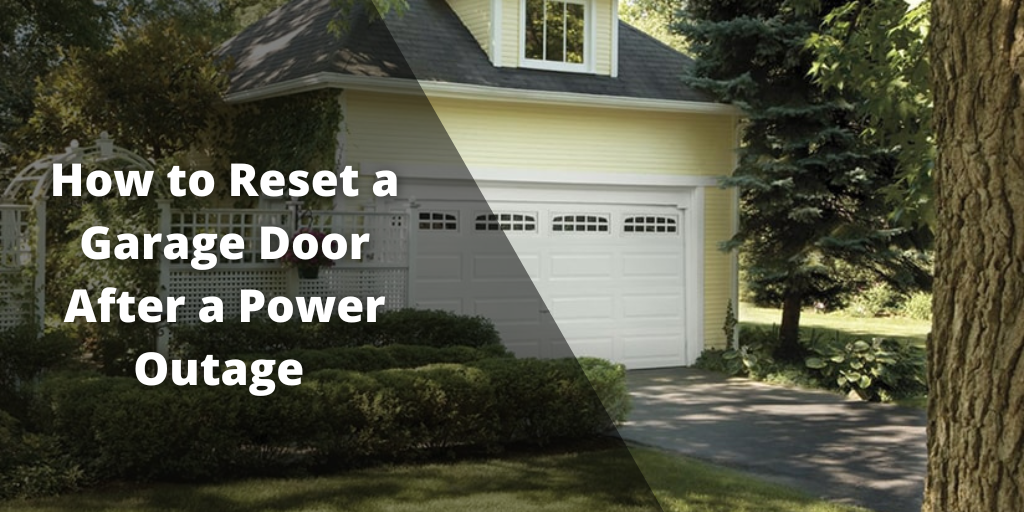
When the power goes out, you’ll likely be concerned about resetting clocks and other appliances in your home. Once you try to pull out of your garage, however, you could realize that you’ve forgotten to reset your door. Your garage door opener won’t work after a power outage because it runs on the same electricity as many other appliances in your home. And when it shuts off due to an outage, it needs a quick restart to start functioning again.
How to Operate an Electric Garage Door During a Power Outage
Before we jump into the specifics, here are a couple of tips for operating your garage door manually while the power is out.
Check the Position of the Door
Your garage door opener won’t work without electricity, so the first step to reset it is to break the connection between the opener and the door. However, before you attempt to disengage the garage door from the opener, check that the door is fully down.
If the power goes out while the garage door is still halfway open, disengaging the opener will cause it to come down quickly. At the very least, the sudden crash will damage the door, but in the worst case, it could injure you or damage any object in its way. While it’s possible to manually close your garage door if it remains partially open after the power goes out, it’s not safe. Have a garage door expert do it for you to avoid potential damage to the garage door system or injuries to yourself.
Pull the Emergency Release Cord
The little red rope hanging from the trolley of your garage door is standard for garage doors, regardless of brand. Pulling the emergency release cord detaches the trolley from the opener carriage, allowing you to lift the garage door. You’ll know the garage door is disconnected from the opener once you hear a little click after pulling the emergency release cord.
Manually Open and Close the Garage Door
Now, you can open your garage door fully and get anything essential out, like your vehicle, then close it manually. Be careful with this step and get help if you need it — make sure you’re closing it slowly. Be sure to close the garage door completely, too. The garage door opener won’t be able to connect until the garage door is fully shut.
A garage door is heavy, but the springs should make it easier to open and close. If it’s impossible to manually lift your garage door, you may have a problem with your springs, which a professional can look at.
How to Reset Your Garage Door Opener After a Power Outage
Follow these steps to reset your garage door when the power comes back after an outage:
Press the Close Button
After power is restored, you can get to work re-connecting the garage door and garage door opener. This shouldn’t be too challenging — just press the button to close your garage. The opener’s chain should automatically move the trolley to the correct position and connect your garage door’s arm.
Manually Attach the Trolley (If Needed)
In some cases, your garage door trolley may not be automatic. If this is true for your situation, then you’ll have to connect the arms of the garage door to the trolley on your own. Pull the red cord in the direction of the garage door until you hear the click. You’ll also see the spring door’s spring retract back into place at this point, and then you can manually reconnect the trolley.
Enjoy Your Functioning Garage Door
Once you follow those steps, the garage should start functioning properly again. Make sure you’re going through each step slowly and cautiously. If it still isn’t working after going through those steps or if you’re having trouble figuring out what you have to do, then make sure you get in contact with a professional service that can help you restore your garage door system to an operational state.
Contact the Garage Door Experts In Tennessee
Your garage door is an essential part of your home. When there’s an outage, you could find yourself stuck without being able to get your car out of the garage. While these steps can help guide you toward a successful reset, there may be times when your door still isn’t working. In those times, you should find reliable repair services like EXL Garage Doors to help.
With decades of experience in the industry and a focus on quality customer service, EXL Garage Doors is your go-to choice for garage door services. Whether you need emergency garage door service, installation, repairs, maintenance, or inspections, our garage door technicians have you covered for all garage door problems. Contact us today!
How to Fix Garage Door Rollers That Are Off Track

When your garage door doesn’t work as it should, getting your car in and out of the garage becomes less convenient. You may have to stop using the garage until you fix the issue, or you may need to get out of your vehicle and manually open and close the door when you leave and return home.
Off-track garage door rollers can lead to several issues. Fortunately, this problem is easy to fix with the help of a professional. You can also take steps to prevent your garage door rollers from going off track in the future.
Why Do Garage Doors Go Off-Track?
The typical garage door has 10 to 12 rollers, and one or more of them may go off track. Some common reasons rollers fall off the tracks include:
- Damaged tracks: Bent or damaged tracks can force rollers out of alignment.
- Loose tracks: The vibration of your door can loosen the bolts that hold the tracks in place.
- Force and impacts: If you hit your garage door with your car, you could send rollers off-track.
- Dirt and lack of lubrication: Built-up dirt and grime, along with a lack of lubrication, can throw rollers off-track.
How to Tell Whether Your Garage Door Rollers Are Off Track
If one or more of your garage door rollers are off track, there should be some visible signs, including:
- A door that’s stuck
- A door that hangs crookedly
- A door that’s hanging loosely
If you notice any problems with your garage door, don’t try to force it open or closed. Doing so could cause further damage to the tracks, push more rollers out of alignment or damage the door’s opening system.
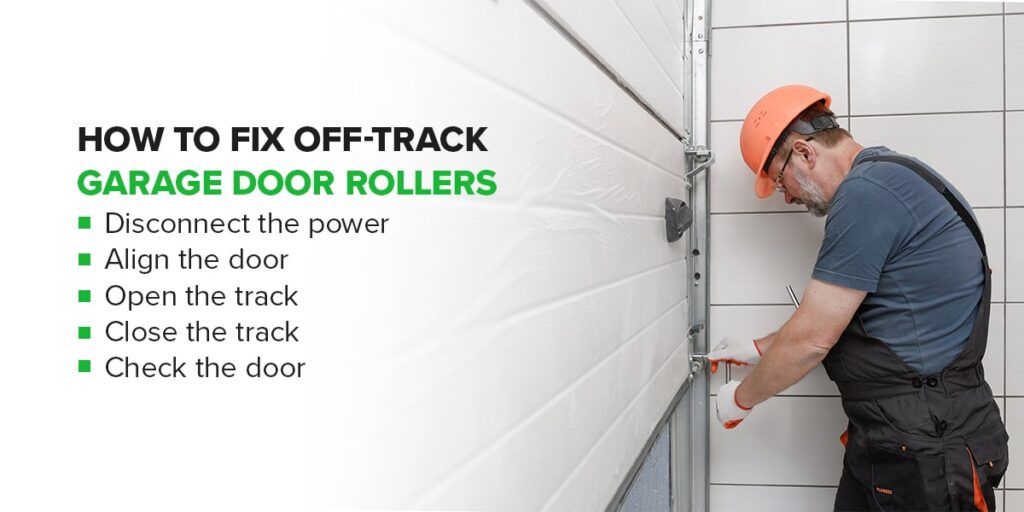
How to Fix Off-Track Garage Door Rollers
The best course of action to take when there’s a problem with your garage door rollers and tracks is to call a professional to inspect and repair the issue. A garage door repair technician will tighten, clean and lubricate the tracks and hardware. They’ll also get to work fixing any problems with the tracks themselves.
While the exact steps a technician follows will depend on the problem, you can typically expect them to do the following:
- Disconnect the power: Pull the rope hanging down from the motor to engage manual operation for the door.
- Align the door: Line the rollers up to the spot where they jumped off the track, locking the door in place with vice grips.
- Open the track: To make room for the roller, use a pair of pliers to work the track open, then guide the roller into place.
- Close the track: Using a rubber or wooden mallet, hammer the track back into shape to prevent the rollers from coming off again.
- Check the door: Open and close the door a few times to check the repair before reconnecting your automatic garage opener.
After the technician has put the rollers back on track, they can provide you with some maintenance tips to prevent the problem from recurring. Basic track maintenance includes:
- Inspecting the rollers and track: Check the track and rollers regularly, such as once a month. Look for signs of dirt or debris buildup and ensure the rollers are in the grooves of the track.
- Lubricate the track: Apply lubricant to the track so the rollers run smoothly. Your technician can recommend the best product for your garage door system.
Turn to EXL Garage Doors for Track Repair
If you’ve noticed a problem with your garage door tracks and rollers, EXL Garage Doors can help. Our professional technicians can get your garage door back on track quickly, either by fixing the track or replacing the rollers.
If your garage door is off-track in the Nashville or Gallatin area, contact EXL Garage Doors today.
notice that any rollers are already off-track, call a professional to assess the situation and complete the right repairs. Such an expert will know how to replace your garage door rollers if necessary. If your garage door is off-track in the Nashville or Gallatin area, contact EXL Garage Doors today.
Flood-Proofing Your Garage Door
For many, a garage is a secure storage location, a place to work or a home for a vehicle. Your garage door should be able to stand up to inclement weather, but periodically verifying that your installation is in solid condition is still a wise move.
It’s always better to take a proactive approach to flood-proofing a garage. This guide will give you tips and steps on how to keep your attached or detached garage dry.
The Reality of Flooded Garages
All it takes is a small imperfection in weatherstripping or a gap between the bottom of a garage door and the ground to let water seep in. Similar to the rest of your home, a garage is enclosed, making it difficult to dry surfaces after water enters. A flooded garage is a surprise no one wants to discover, as mold growth can begin shortly after a storm passes through.
The reality of a flooded garage is you can be set back in more than one way. First, the vehicles, tools or personal belongings you keep in the enclosed space are at risk of damage, and second, you could end up paying thousands of dollars in structural repairs. It’s worth taking garage door flood prevention seriously to sidestep a major headache and financial burden down the road.
Why Garage Flooding Occurs
Garage door flooding can happen due to several events, some of which are more preventable than others. The most common reasons for garage door flooding are below:
- Weather-related instances: Rainstorms and wind put stress on garage doors. Bent panels, compromised seals, missing hardware and crooked tracks allow water to enter easily during these events. Contacting a professional for repairs before a storm strikes is your best move to prevent flooding.
- Sewage backups: Intense rainfall, plumbing clogs and cracked connections may result in water rising from drainage outlets. Monitor your property for standing water that sits close to your garage door entrance.
- Faulty home water pipes: You could have plumbing connections freeze and crack. This results in gallons of water leaving the system and pouring into your garage from above or through nearby walls.
How Can I Stop My Garage From Flooding?
Determining how to keep water outside your garage door may look different based on the age of your overhead door installation and where on your property the garage door sits.
Garages can flood from multiple angles — via the door, up through the ground, or through walls and ceilings. Prepare for unexpected events by walking around your property to see where you can make changes from outside your storage space.
Preventive Measures for Attached and Detached Garages
An excellent way to reduce the likelihood of your garage flooding is to put gutters around the perimeter. Gutters allow you to guide water away from your home’s exterior and toward drains or the street. You might also explore flood prevention measures such as:
- Waterproof veneers: Coatings for wood are useful in keeping moisture out of garages.
- Foundation repairs: Seal up cracking concrete below your residential space to ensure water stays out.
- Landscaping: Cleaning up yard clippings and leaf piles around the garage stops hidden puddles from lingering and growing larger.
- Stack sandbags: Bags of sand make outstanding barricades. Build a dam to block water or direct it toward an exit path.
- Install traditional drains: A professional may put additional drains in and around the garage to help water leave quickly.
- Create French drains: A French drain is a trench filled with gravel that redirects water. Placing one near your garage can help prevent pooling and flooding.
- Storm shields: If your concrete surface is unlevel, consider using a rubber barricade at the bottom of the garage door to prevent water entry.
- Lawn maintenance: Check your property for moving water that flows toward the garage — you may be dealing with poor grading.
How Do You Flood-Proof a Garage Door Installation?
Your garage door is in the line of fire during a severe storm or emergency. You likely open and close your overhead door dozens of times a week, so it’s a good idea to use your eyes and ears to detect issues with an assembly before the forecast takes a turn. Note that you should only have an experienced professional perform garage door maintenance and repairs, as the springs are under high tension and require training to work on safely.
It’s important to realize that it’s impossible to have a 100% waterproof garage door — but there are methods that can help in stopping water from reaching your storage space.
Before you start the process, request an inspection to have a trained technician come to your residential space and identify areas requiring attention. Keep these recommendations in mind to flood-proof a garage door.
1. Replace Garage Door Weatherstripping
Weatherstripping lines the bottom and sides of your garage door. It’s best to visually inspect this element between seasons to ensure it is still doing its job. From noticeable gaps in weatherstripping to sections that appear dry or discolored, issues with this material may allow water to enter your garage. The right garage door team can apply new weatherstripping for your peace of mind.
2. Change the Door’s Cables and Springs
An uneven garage door does little in the fight against flooding. You’ve probably noticed all of the cables and springs that make up your overhead door assembly — these components hold an incredible amount of tension and should be assessed periodically to gauge their reliability. Schedule cable and spring repair services to get your overhead door to sit even with the ground and keep water out.
3. Update or Replace the Hinges
Your garage door features hinges between moving parts. The panel surfaces require these hinges so the overhead assembly can move from the open and closed positions freely.
Hinges on panels will eventually wear out with time and use, leaving weak spots across surfaces where water can enter. Having an expert replace worn hinges is effective for protecting your space and increasing the structural integrity of your installation.
4. Replace Your Overhead Door
There comes a time when it’s more cost-effective to select a garage door replacement than repair an old model. A reliable local garage door company will be able to provide a range of styles to choose from — each from a world-class manufacturer. If you live in the Nashville, Gallatin or Franklin, Tennessee, area, know that EXL Garage Doors would love to assist you.
Choose EXL Garage Doors for Maintenance Services
EXL Garage Doors prides itself on offering exceptional customer service. With our showroom in Tennessee, you can look at Clopay® garage door models up close before you purchase. We also provide flexible repair and maintenance appointments across a wide service area. If you need assistance keeping water out of your garage, we have the products and capabilities to serve you.
Our team is here to ensure you’re entirely satisfied with the outcome of your garage door project. Request a service appointment today!
Is My Garage Door HOA Compliant?
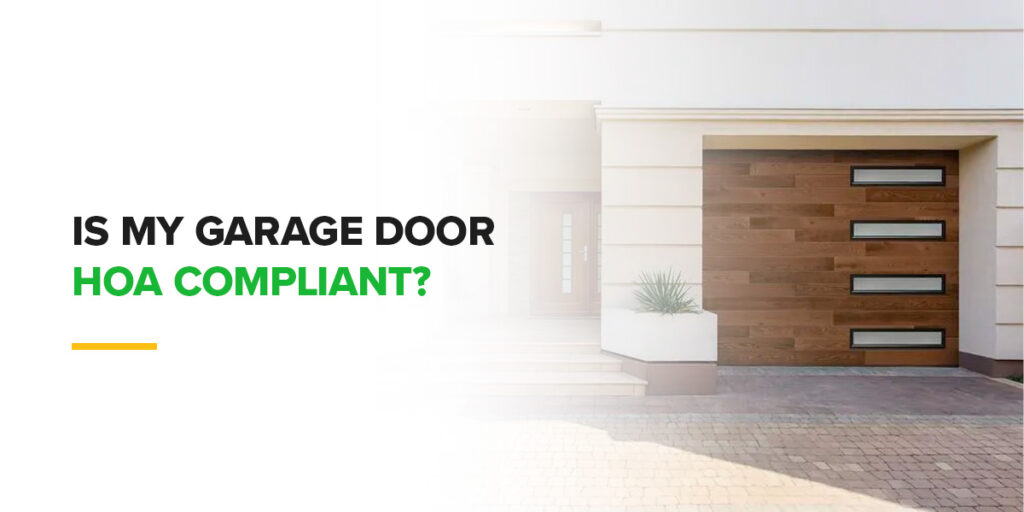
A homeowners association (HOA) is an organization that oversees a community of houses, high-rises, condos or townhouses. Members pay membership fees for the upkeep of the community and follow HOA guidelines.
The homeowners association typically consists of elected resident volunteers who enforce HOA rules and regulations. These regulations cover the use and maintenance of your home and common areas, which can include your garage door.
HOA Garage Door Rules
Your HOA can have regulations about the style, functionality and maintenance of your garage door. If you fail to comply with these rules, you might be subject to fines or a lien. You should consult your HOA about their specific guidelines, but here are some of the standard HOA regulations for overhead doors.
Style
One of the main functions of an HOA is to maintain the community’s appearance. With that in mind, it makes sense for an HOA to have style guidelines for your garage door. Most HOAs want residents to keep their overhead doors clean, well-maintained and aesthetically pleasing. They would not allow cosmetic damages such as:
- Dents
- Scratches
- Paint chips
- Fading paint
- Cracked windows
- Peeling paint
- Damaged panels
- Broken windows
- Rotten panels
- Rust
Additionally, if you need to replace your garage door, you probably have to choose a similar style and design. If the style is no longer available, your HOA can approve a new door. In general, you should obtain your HOA’s approval before replacing your door so you don’t choose one against regulations and have to replace it again.
Functionality
HOAs can create regulations regarding your overhead door’s functionality. The associations that do often require your door to open and close smoothly and quietly. It’s inevitable for your overhead door to make some noises, but these noises shouldn’t be loud or unusual.
Your HOA can also require your garage to have internal ventilation. Internal ventilation can prevent the buildup of toxic gases from running vehicles. Additionally, the association may want your door to remain closed when not in use. One HOA proposed homeowners should keep their garage doors open from 8 a.m. to 5 p.m. The regulation was supposed to prevent homeowners from allowing others to live in their garages. This idea shows HOAs can create regulations for almost everything.
Maintenance
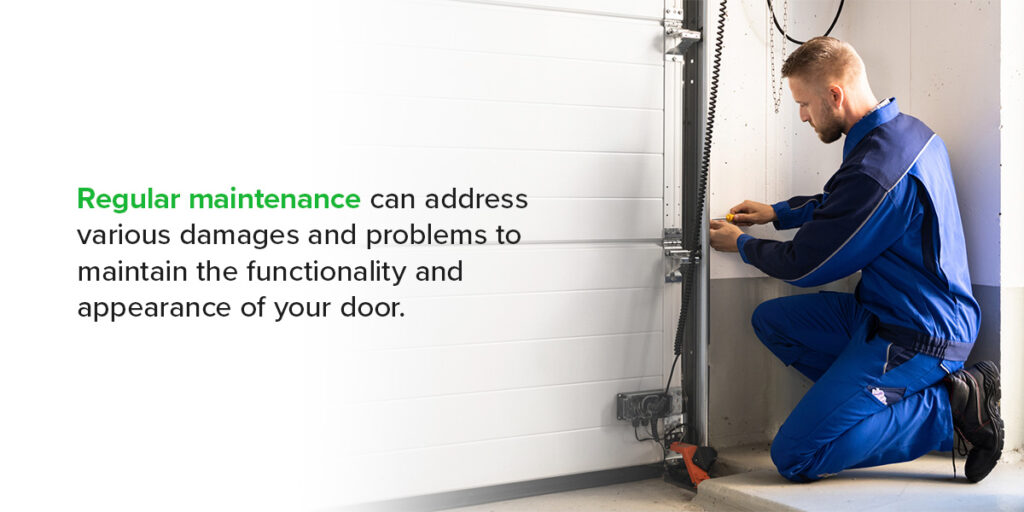
HOA garage door maintenance guidelines might require homeowners to schedule routine maintenance to keep their garage doors in excellent condition. Regular maintenance can address various damages and problems to maintain the functionality and appearance of your door.
Aside from complying with the HOA rules, garage door maintenance can extend your door’s life and prevent costly repairs. When a professional comes to maintain your overhead door, they perform essential upkeeping services, like lubricating moving parts, tightening nuts and bolts, and inspecting your door for problem areas. If they notice any problems, they’ll inform you and suggest a plan. Early awareness allows you to address issues before they become more significant and costly. For these reasons, regular maintenance can prevent your door from breaking down suddenly.
How to Meet HOA Requirements
To meet HOA garage door requirements, speak with leaders in the association to learn what rules you need to comply with. From there, the best way to meet your HOA’s garage door requirements is to hire a professional to maintain your garage periodically. As a bonus, garage door maintenance offers other benefits, including:
- Maintaining functionality: A professional will check and repair your cables, springs, openers and rollers so they remain in good condition.
- Increasing longevity: Since technicians alert you to problems as they arise, you can fix them before they get out of hand and cause your door to malfunction. By addressing problems as your door ages, you ensure it lasts longer.
- Saving money: Maintaining your garage door typically costs less than repairing or replacing it.
- Increasing security: Many homeowners can enter their homes through their garages. If your garage door system is in poor condition, an intruder could also enter your garage and home.
- Preventing damage: Your garage door can malfunction while entering or exiting your garage in your vehicle. If your door closes on your car, it can cause severe damage.
- Maintaining appearance: When your garage door has a problem, it can be noticeable enough to lessen the aesthetic appeal of your home. For instance, a misaligned door can appear to sag when open halfway.
- Maintaining your warranty: Most manufacturers offer a warranty on their products. However, the warranty can stipulate that you employ routine maintenance services, or it’ll be void.
How Often Should You Schedule Maintenance?
The frequency of your maintenance checks should depend on your preferences and HOA requirements. Some HOAs require annual maintenance, but you might prefer seasonal checks. Seasonal maintenance can ensure your garage functions appropriately in preparation for the next thunderstorm, heat wave or snowstorm.
EXL Garage Doors Can Maintain, Repair or Replace Your Garage Door
EXL Garage Doors is your local, trustworthy garage door services company in Tennessee. When you schedule maintenance with us, we’ll work with you to ensure your door functions properly for many years and complies with your HOA’s rules.
If our expert technicians notice anything amiss during your maintenance inspection, they can repair or replace your garage door. We can fix countless problems, but in some cases, a new garage door will benefit you more. Here are some signs that you need to replace your garage door:
- Frequent maintenance: If your garage door requires frequent maintenance or repairs, you could benefit from a new garage door system.
- Loud operation: As your door ages, it may shake or make loud and unusual noises. While this can indicate that your door needs maintenance, it can also mean you need a new one.
- Slow operation: After sending a command to your door, it should respond within a few seconds. If your door is slow to open or close, you might need to replace it.
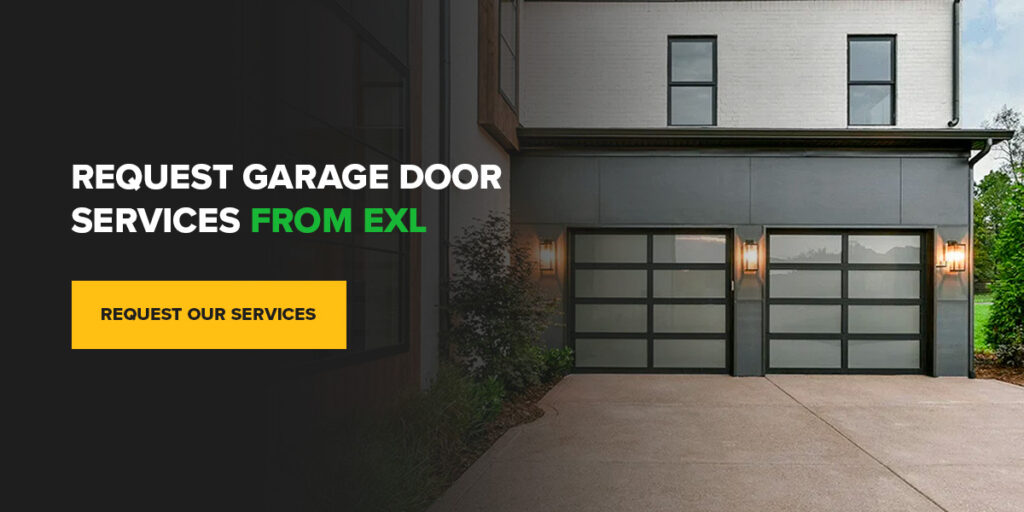
Request Garage Door Services From EXL
Whatever you need — be it maintenance, repairs or replacements — EXL Garage Doors can do it all. With our years of experience, no project is too big. In fact, we love to transform our clients’ garages into tricked-out ones. HOAs often govern luxury communities, so it makes sense for residents to have luxury garages with unique features to increase comfort and convenience.
Contact us today to receive a free estimate or request our services. We’ll help you get the most money out of your investment while meeting your HOA’s regulations.
How to Weather Seal a Garage Door

Weather sealing a garage door comes with many benefits to take advantage of. Though it might seem simple, weather sealing a garage door actually takes a few different intricate steps. It will help to learn how to seal the bottom of your garage door before you dive into the project.
1. Find the Right Product
The first thing you’ll want to do is find the right weather stripping for your garage door. You’ll need to measure the dimensions of your door so that you can match the thickness and width of your weather seal. You should also consider the climate you live in, so you can find a product that will give you the best defense against the elements.
If you’re unsure about what weather sealing to get, make sure you’re getting in touch with a reliable service like EXL Garage Doors that can help you find what you need.
2. Remove the Old Seal
Once you have the right weather seal, it’s time to figure out how to remove the old garage door seal. For this, you may have to remove two screws at either end of the garage door. Depending on what type of garage door you have, you may be able to just pull the old seal free or have to slide it through one end. In some cases, you may need to use a hammer to pull nails free so that you can remove the seal.
3. Clean Out the Door
After your old seal is removed, remove any dirt, debris and remaining pieces of sealing from the door. If there are nail holes, use filler to cover these. If your door doesn’t have a track in place, you may want to consider installing one for the new seal.
4. Install the New Seal and Trim Off Excess
Raise the garage door to eye level and then start securing your weather seal. Again, this will depend on the type of setup you have — for doors with tracks, you’ll be able to weave the seal through grooves and feed it through the rest of the way. For doors without tracks, you’ll be able to hammer the seal into place.
Benefits of Weather Sealing
Though now you may know how to replace a garage door bottom seal, what’s the point in doing it? Weather sealing your garage door does offer many benefits, such as:
- Insulation: Weather seals can help keep out extreme temperatures, which can help your garage stay cooler and keep your home more comfortable. You’ll also be able to save on energy bills.
- Protection from water and debris: While weather sealing may not be completely waterproof, it can help resist moisture and keep dirt and debris from entering your garage.
- Defense from pests: Insects and small rodents may try to find their way into your garage through the bottom of the door. Weather sealing helps defend against unwanted pests.
Contact EXL Garage Doors
Whether you need help finding the right weather sealing, need a replacement or need another type of garage door service, EXL Garage Doors has you covered. We offer the expertise, reliability and quality workmanship you’re looking for. Contact us today!
How to Test Garage Door Sensors
An automatic garage door system has two infrared sensors mounted approximately 2 to 6 inches above the ground on either side of the opening. These devices perform two crucial functions. First, they signal the door to open and close when you press the appropriate button on the opener’s remote control. The sensors also ensure safety by preventing the door from closing if an object enters the path of the electronic beam connecting the two photo eyes.
How to Tell If a Garage Door Sensor Is Bad
Faulty sensors will likely impact your garage door’s functionality and pose a safety hazard. You can determine whether you have a potential sensor issue by checking for these signs:
- Dirty lenses: The sensors won’t operate properly if dirt or debris obscures their sight. Fix the problem by wiping the lenses with a soft, clean cloth and a gentle detergent.
- Wire damage: Garage door sensors rely on wiring that connects them to the door opener’s motor. Damage to these cables can prevent the sensors from working correctly. Look for signs of insect or rodent gnawing, water damage, tampering or fraying, and make a replacement if needed.
- Misalignment: Your sensors include LED lights that indicate whether they are out of alignment. A blinking light means that the photo eyes aren’t facing each other at the appropriate angle, but you can correct this issue by repositioning the sensors.
- No power supply: If the LED lights aren’t displaying at all, they may not have power. Check the wiring or the opener to see if you can find the problem.
- Wetness: Rain or dew that collects on the sensors may cause them to malfunction temporarily. The problem often goes away when they dry.
How Do You Test Garage Door Sensors?
You can perform a simple test to determine if your garage door’s sensors are working properly. With the door in the raised position, place a cardboard box or another similar-sized object in the door opening in front of one of the photo eyes. Press the button on the opener’s remote control unit to initiate the closing process.
If the sensors are functioning correctly, they’ll transmit a signal to the opener to indicate that an object is in the doorway, which activates the auto-reverse mechanism. This safety feature causes the door to change direction and move upward. If the door closes on the box, perform the troubleshooting steps listed above to pinpoint the issue.
How to Reset Garage Door Sensors
If the issue persists, you can attempt to reset the sensors by reprogramming the garage door opener. The resetting process on a newer model typically involves pressing a button labeled “Learn” or “Home,” but you can also consult the owner’s manual for step-by-step instructions.
Garage Door Sensor Not Working? Contact EXL Garage Doors
If you live in or near Gallatin, TN, the professionals at EXL Garage Doors can help you determine the cause of malfunctioning sensors. Contact our expert team online to request a convenient service appointment.
What to Do If Your Garage Door Spring Is Broken

If you’ve recently encountered problems operating your garage door, it may have a problem with its springs. The garage door springs are essential for lifting and closing the door effectively. When one or both of them are damaged, then your door won’t be able to operate as it should.
If you think something has happened to your garage door springs, it’s important to know the signs and symptoms that can confirm your hunch. A garage door with broken springs can also be dangerous, which makes it all the more essential for you to understand the ins and outs of broken springs.
How to Identify a Broken Spring
There are a variety of ways to identify a broken spring. The key is to proceed cautiously so that you can protect yourself and others in your home from harm. Be on the lookout for these warning signs of a garage door spring break.
1. Your Garage Is Struggling to Open
A broken spring means your garage door has lost a central part of its operations — when you try to open it, the door will likely struggle to work. If the door is opening crookedly or not opening at all, it’s likely that there’s something wrong with the springs.
2. Your Door Closes Too Fast
When working properly, garage door springs release tension slowly as the door closes to prevent it from banging into the ground. When the springs are broken, there is nothing to keep the door from shutting rapidly. When you close your garage door and see it close very fast and with a bang, then you probably have a broken spring.
3. Loud Snapping or Cracking Noises
Sometimes you may actually be able to hear a garage door spring break — these are characterized by loud cracking or snapping noises. When you hear one of these noises emanate from your garage, there is a good chance it was caused by a snapping spring.
4. Noisy Operations
Along with struggling to open, a garage door with broken springs will also likely have very loud operations. Instead of the smooth, measured opening and closing of a properly-functioning door, it will produce crooked operations and banging, grinding or screeching noises.
5. Weathered Springs
You can also take a look at the springs to see if they’re damaged. Sometimes the springs may actually still be intact, but they’ve become so rusted and weathered that they can no longer do their job.
How to Fix a Broken Garage Door Spring
While it may be tempting to try to fix a garage door spring yourself, it’s best to leave that job up to a garage door professional. Broken springs are under enormous amounts of pressure, and they can cause injury or damage to objects in your garage. Be sure to err on the side of caution and contact a service you can trust for help.
Contact EXL Garage Doors
If you need garage door service for torsion springs or extension springs in the Gallatin or Nashville, Tennessee, area, then EXL Garage Doors has you covered. With over 20 years of experience and a commitment to our customers, we’re the professional garage door company you can trust. Contact us today!
How to Keep Your Garage Cool in the Summer and Warm in the Winter
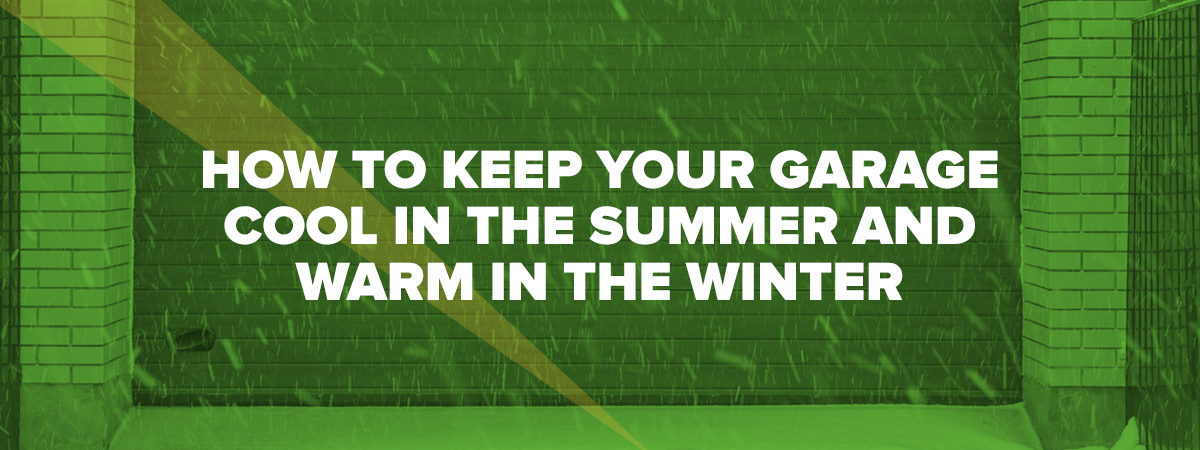
Many people today use their garage door as the main entryway to their home as opposed to the traditional front door, resulting in garage doors opening and closing numerous times throughout the day.
In the colder months, this means letting more frigid air enter, and in the hot months, more heat is coming in. The best way to combat extreme weather in the winter and the summer is to insulate your garage and make it climate-controlled, keeping it nice and warm in winter and cool in the summer, adding extra protection and saving you energy.
Garage Door Insulation Kits – The Best Way to Keep Your Garage Warm in the Winter and Cool in the Summer
While adding space heaters in the winter or portable fans in the summer can help regulate how warm or cool your garage is, insulation is ultimately the best way to keep your garage cool in summer and warm in winter. Insulation helps control your garage temperature since it reduces air loss and prevents air from getting in. Since garages are one of the worst parts of a home when it comes to energy efficiency, insulation is crucial.
When you control your garage’s climate and temperature using insulation, you’re also keeping energy costs down as you reduce the amount of energy necessary to heat up or cool down the rest of your home. Insulating your garage doors with insulation kits also makes your garage door more sturdy, since insulation helps strengthen the door and makes it less susceptible to dents from accidentally hitting it or other damage by natural elements.
Insulation kits also reduce noise from opening and closing your garage door and decrease any noise from outside your door. Insulation allows you to use your garage for your favorite hobbies or recreationally, making it a comfortable and controlled atmosphere no matter the weather.
When you search for an insulation kit, look for one with a high R-value. R-value measures how effective a material is at insulating based on its chemical properties and thickness. The higher the R-value, the more effective the insulation. However, when it comes to R-values for garage doors, they can sometimes be measured using different methods. This makes it challenging to figure out what R-value you specifically need to insulate your garage door, so it’s always best to seek professional assistance to find the right insulation kit for you.
Additionally, insulation kits require careful precision to cut the insulation to fit your garage door panels perfectly before securing them on. To ensure that your insulation kit works the way it should and your garage can stay warm in the freezing cold and cool in the scorching temps, trust a professional to install your garage door insulation.
At EXL Garage Doors, we offer insulation kits and professional installation services, as well as a variety of Clopay insulated garage doors for your home if you’re looking for a complete door update.
How to Keep Your Garage Warm in the Winter
Even if you only use your garage for storage, freezing winter temperatures can infiltrate your garage and affect your belongings, such as your car. Colder temperatures can ruin your car’s battery, thicken its fluids, cause low tire air pressure and lead to unreliable wiring and spark plugs.
Plus, if you often work or do any recreational activity in your garage, it needs to be habitable, and freezing temps can quickly make it unbearable. Garages act as a nice buffer as far as temperature goes from the outdoors to inside your home. Garages should be warmer than outside, and, though they may not always be as warm as your home indoors, you should be able to go from your home to your garage to grab something without having to put on all your winter layers.
In addition to adding insulation, you can use other tips to help keep your garage warmer when it’s cold outside. Try the following to control your garage’s temperature year-round.

1. Clean Your Garage
To find the best way to control the climate of your garage during the winter, start by giving your garage an excellent, thorough cleaning. After all, what good is adding improvements to your garage if it’s still a mess?
2. Check Your Weather Stripping
After you organize and clean it up, inspect your door and look at your weather stripping. Over time, your weather stripping could crack and break, and if water finds its way in, it can freeze and make your garage door stuck, unable to open. Broken weather stripping also leads to some severe air leaks which allow the cold winter air to come in.
To replace your weather stripping, remove the existing weather stripping and scrape off any leftover sealant (not all doors will have sealant that needs to be removed, especially doors that were installed within the last 20 years). To put on your new weather stripping, you must accurately measure it and line it up to the door to ensure your seal is tight. Close the garage door and put the stripping down so the rubber flap is pressed against the door.
3. Seal Other Air Gaps
Your weather stripping isn’t the only place cold air can enter your garage — other doors and window units are also prime spots for air infiltration. Inspect the area carefully to see if the caulk has broken. If the sealant is in bad shape, it can also promote mold growth or wood rot in addition to letting in cold air.
It’s generally best to remove the old caulk before applying new. Start at the top and use consistent pressure with a putty knife or other sharp tool to remove it, then clean the surface thoroughly before applying the new sealant. For extra protection, add affordable plastic window film to help keep cold air out.
4. Add Insulation to Uninsulated Walls and Ceilings
If the exterior walls and your garage’s ceiling aren’t currently insulated, now’s the time to change that. You have multiple options for doing so, including:
- Spray foam insulation.
- Rigid foam insulation.
- Batt foam insulation.
This small addition can also help reduce noise, which is useful for those who use the garage to pursue hobbies.
5. Consider Adding a Heater
You can also explore various heater options to keep your garage warm during the winter months. Think about the amount of space you have in your garage and shop around accordingly.
If you’re scarce on space, you may even want to consider a wall-mounted heater. Mounted electric heaters are easier to install than a forced-air heating system, so you may be able to install them on your own. However, you could also go with a forced air heater or convection heater.
For convenience, a portable space heater or propane heater could work best since they come in various sizes, making it easy to find one that works for your space and meets your heating needs. Unit heaters are also compact and relatively simple to install, and you can choose to run it on electricity or gas. You may opt to put in a mini-split heat pump to save even more energy.
How to Keep Your Garage Cool in the Summer
Similar to how you want to protect your garage from frigid winter air, you also need to keep it cool when summer brings extreme heat. Our tips for helping do that include the following.
1. Take Advantage of Natural Ventilation
In addition to insulation kits or insulated garage doors, you can find ways to use natural ventilation to keep your garage cool, especially if it has no windows. By opening any outside-facing doors, windows or other doors besides the one that leads to your home, you increase the air circulation inside your garage, keeping things moving and preventing your garage from feeling too hot.
2. Plant a Tree
This solution is good for the environment, wildlife and your wallet. Adding a tree can help shield your garage from the sun during the hottest parts of the day and maintain a lower temperature inside.
Some shady trees include walnut, maple, ash, oak and magnolias. Since they lose their leaves each fall, you’ll benefit from the winter sun to keep your garage warmer during the cold months.
3. Let Your Vehicle Cool First
Pulling a hot car into a garage and closing the doors traps the warmth in your garage space as your vehicle cools down. A better solution is to park your car in a shady spot to let it cool first and keep the extra heat out.
4. Try a Fan
Portable fans are an affordable option that you can set up near your open doors, pointed inside your garage to draw the cool air from outdoors and pump it into your garage. You can choose from several styles of fans, such as pedestal fans, box fans or high-powered shop fans. Still, you should note that fans don’t really improve the overall garage temperature and climate as much as they boost airflow, making it feel significantly cooler inside your garage.
You could also install a ceiling fan if your garage permits. Typically, garages need to be at least 8 feet tall to install a ceiling fan. You must also make sure the blades of the ceiling fans are between 7 and 9 feet above your garage floor and between 10 and 12 inches under the ceiling.
5. Consider the Benefits of Air Conditioning
Before you decide to incorporate air conditioning into your garage, you should think about how often you’re using it and how cold you need it to get. If you spend a lot of your time in your garage and determine air conditioning is a necessity for your garage, consider installing a window air conditioner unit or a portable floor unit as a more affordable airflow option.
6. Keep Your Garage Clean and Organized
Keeping a clean, organized garage will also benefit you in the hot summer months as airflow can circulate better when there’s no clutter around your garage. As some other added methods you could incorporate to beat the heat, consider installing some attic vents for heat to escape through or put in a dehumidifier for humidity control to prevent your garage from feeling like a summer swamp. Protect your belongings and work in comfort by discovering the best approaches for how to keep a garage cool in summer.
Trust EXL Garage Doors to Install Your Insulation and Keep Your Garage Temperature Under Control

Whether you spend hours a week in your garage or want to protect your valuables inside, it’s time to upgrade your garage for energy efficiency with insulation to ensure temperature regulation and climate control no matter the weather outside.
Whether you’re looking for an insulation kit or a complete door replacement, EXL Garage Doors can provide you with quality materials at great value and professional installation and maintenance services for any of your garage door needs. With more than 20 years of experience serving the Gallatin, Franklin and Nashville, Tennessee, don’t wait to see what we can do for you. Request a free estimate or contact us to start your garage remodel today.
